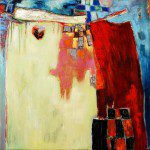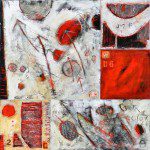David Richardson at the Ralls Collection
By • July 26, 2011 0 2078

It is rare to find such a steady and yet exciting subject as is found in both the paintings and the person of artist David Richardson. With an astonishing discipline, he has explored and unraveled three series of paintings, any one of them strong enough to exhibit individually. In a roiling assault of nebulous symbols – some seemingly unconscious, some loud and overt – and vast planes of bold colors and textures, his work recalls a landscape both foreign and familiar, contained yet effusive. Richardson’s work seems to be chasing something beyond the artist’s own vision. The revisiting and evolution of repeated shape and composition unfold like chapters of a great novel: questioning, but sure of the direction. His exhibition at the Ralls Collection, running through the end of the year, establishes him firmly in the forefront of abstract painters of the day. The exhibit is one of the highlights of the visual arts season. The Georgetowner sat down to speak with Richardson
about his work.
David Richardson’s exhibit, “Trojan War Years,” is on display at the Ralls Collection from October 6 – December 31. For more information, visit www.RallsCollection.com
Where are you from? How did your upbringing shape your life as a painter?
I’m from Michigan. Most folks think of Detroit when they think of Michigan. That’s not the Michigan I come from. I grew up in a semi-rural environment – a marshland with a river meandering
through it. My brothers and I fished a lot, trapped raccoons and muskrats for their hides and ran the river in canoes camping and shooting guns. It is romantic to me now. It wasn’t then. My mom and older brother painted. My mother was still selling her work and teaching painting in her house when she died last year. Today, my brother lives in Germany, paints and exhibits his work around Europe. As a kid I drew a lot and eventually began painting, following in the footsteps of my mom and older brother. I don’t remember when I first drew or painted. It was early in life. I started college on an art scholarship, but I didn’t much take my own painting seriously until I was twenty-three or so.
Did your experience in the military and combat impact or inspire your work?
Somewhat. Of course travel, particularly to Asia, has had an impact on my work. I’d been to Europe before joining the service, but I went to Asia only because I was sent there. It turned out a good experience. The impetus of all three series the Ralls Collection is showing came while I was overseas.
It gets a little more personal than that, though. During the initial stages of the war, I was left behind teaching at George Washington University. This was somewhat traumatic for me as my closest friends were with combat units and participating in operations in Iraq and Afghanistan. The agony of watching from the sidelines pushed me further into painting. At the time I was working on the early stages of the series based on the Japanese stone markers. I began to title them using characters from Homer’s Iliad. I had that text on hand because I’d refer to it now and then in class. The characters in the Iliad are nuanced and the war brings out the worst and the best in them. Of course, it’s the same in real life. It’s not an accident that the Iliad is the fountainhead of Western literature. It still resonates twenty-five hundred odd years later. At least it did with me.
While working on a series as comprehensive as the Trojan War Series, you impose upon yourself very strict limitations and boundaries, in terms of composition, value, concept, etc. In establishing these boundaries, what have you noticed in the transformation of the work, and your own styles and objectives in painting?
That is a tough question. It’s tough because I never consciously set the boundaries. They evolved, and they evolved out of figurative painting. The evolution took a long time – about fifteen years. But once I had this framework, it became this box where I could practice color, composition and other elements of painting. Another way of looking at it is that I’ve used the stone motif and the symbol of the cross much as somebody would use the figure or still life to practice picture making. I’m always looking for a new box to practice within, by the way.
Your paintings are abstract, to be sure, but they draw largely upon tangible elements: the streets of Seoul, neon crosses, inscribed Japanese stones, military symbols, even stencil lettering. How do you define your style of working?
Well, I’d say it falls generally into the broad category of Modernist type painting – Clement Greenberg’s term. Beyond that, I don’t know how to categorize it. I’d leave that to someone who knows more about art than I do.
Did you work on many of these pieces living abroad? How did that affect the outcome of the work?
I didn’t paint anything from the series based on Japanese stone markers and Homer’s Iliad when I was overseas the last time. I tried, but it simply didn’t work. I ended up doing composite work based on some visuals I picked up in Seoul. However, the paintings did not start out as composites. That evolved. I was actually painting symbols on small canvases that I carried home on my bike from a carpenter’s shop. I had painted about twenty of these small pieces when I started organizing them into larger pieces. Some of these pieces are at the Ralls Collection now. You can see I clamped the canvases together tightly and then secured them in place with screws. The result was sort of organized chaos, that thing that often seems to surround one while living in a foreign country.
Who are some of your influences as a painter?
Adolph Gottlieb was the first non-figurative painter I became transfixed by, so that’s a start. Richard Diebenkorn and Robert Motherwell are others that everybody knows. Yet I remember being in Mexico in the mid-nineties and seeing profound folk paintings based on simple motifs. The same goes for pictures I saw in Japan and Korea. Now I wish I’d collected some of these pieces. Closer to me, the Washington DC painter John Blee has had a big impact on the tone of my work. Looking at Blee’s work keeps my palette from getting too somber. His dedication to painting is unmatched.
Of course from an early age, both my brother’s and my mother’s painting greatly influenced my work. I used to tell my mother I stole her color palette–she said she didn’t mind, by the way. My brother opened my mind to the possibilities of figure abstraction and abstraction in general.
What are your favorite museum exhibits in DC right now?
The American Modernism showing at the National
Gallery right now. I particularly like the pieces by Dove, Marin and Hartley. I’ve spent a lot of time out of the country – so much that I have developed a particular passion for things American: skyscrapers, cowboys, highways through the desert, the Shenandoah Valley and the bravery of our painting. Go anywhere you wish in the world and you can’t beat the boldness of Avery, Pollock, Kline, Basquiat, Johns or Rauschenberg. These painters aren’t in that particular exhibit, but you get what I mean.
What would your advice be to a painter struggling with inspiration, unsure of what to paint?
Well, you know the thing about inspiration…a little goes a long way if you work hard after the fact. I don’t think what you paint actually matters. Find something that interests you and attack it, hard. Paint that, then go to museums and exhibits and look at painting. See how others are doing it or did it. Then, go back and paint more and then look at more painting. Keep doing it. Hang out with other painters and talk about it. Eventually, it melds into something cohesive and true.
- David Richardson’s paintings at the Ralls Collection





